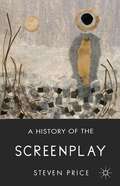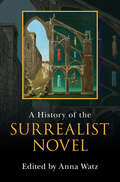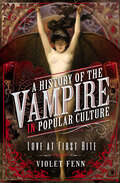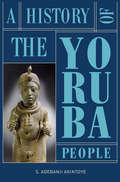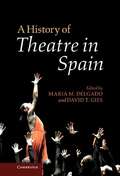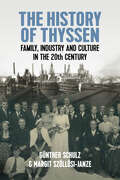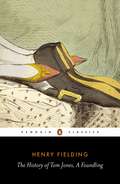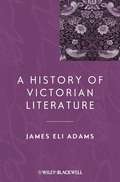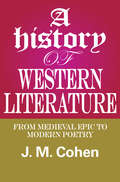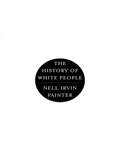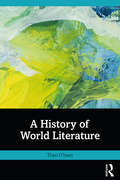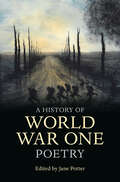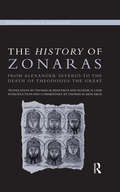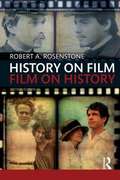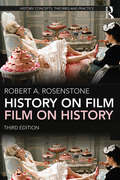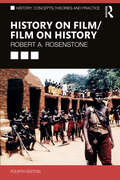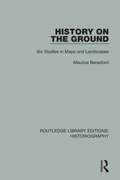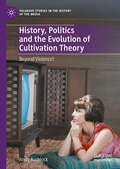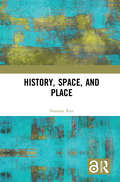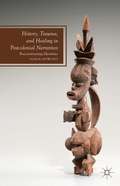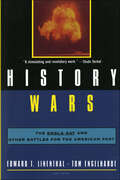- Table View
- List View
A History of the Screenplay
by Steven PriceThe screenplay is currently the focus of extensive critical re-evaluation, however, as yet there has been no comprehensive study of its historical development. International in scope and placing emphasis on the development and variety of screenplay texts themselves, this book will be an important and innovative addition to the current literature.
A History of the Surrealist Novel
by Anna WatzA History of the Surrealist Novel offers a rich, long, and elastic historiography of the surrealist novel, taking into consideration an abundance of texts previously left out of critical accounts. Its twenty thematically organized chapters examine surrealist prose texts written in French, English, Spanish, German, Greek, and Japanese, from the emergence of the surrealist movement in the 1920s and 1930s, through the post-war and postmodern periods, and up to the contemporary moment. This approach extends received narratives regarding surrealism's geographical locations and considers its transnational movement and modes of circulation. Moreover, it challenges critical biases that have defined surrealism in predominantly masculine terms, and which tie the movement to the interwar or early post-war years. This book will appeal both to scholars and students of surrealism and its legacies, modernist literature, and the history of the novel.
A History of the Vampire in Popular Culture: Love at First Bite
by Violet FennAn exploration of the continuing appeal of vampires in cultural and social history. Our enduring love of vampires—the bad boys (and girls) of paranormal fantasy—has persisted for centuries. Despite being bloodthirsty, heartless killers, vampire stories commonly carry erotic overtones that are missing from other paranormal or horror stories. Even when monstrous teeth are sinking into pale, helpless throats—especially then—vampires are sexy. But why? In A History Of The Vampire In Popular Culture, author Violet Fenn takes the reader through the history of vampires in &“fact&” and fiction, their origins in mythology and literature, and their enduring appeal on TV and film. We&’ll delve into the sexuality--and sexism--of vampire lore, as well as how modern audiences still hunger for a pair of sharp fangs in the middle of the night.
A History of the Yoruba People
by Stephen Adebanji AkintoyeA History of the Yoruba People is an audacious comprehensive exploration of the founding and growth of one of the most influential groups in Africa. In this commendable book, S. Adebanji Akintoye deploys four decades of historiography research with current interpretation and analyses to present the most complete and authoritative volume on the Yoruba to date. This exceptionally lucid account gathers and imparts a wealth of research and discourses on Yoruba studies for a wider group of readership than ever before. Very few attempts have tried to grapple fully with the historical foundations and development of a group that has contributed to shaping the way African communities are analysed from prehistoric to modern times."A wondrous achievement, a profound pioneering breakthrough, a reminder to New World historians of what 'proper history' is all about - a recount which draws the full landed and spiritual portrait of a people from its roots up - A History of the Yoruba People is yet another superlative work of brilliant chronicling and persuasive interpretation by an outstanding scholar and historiographer of Africa.~ Prof Michael Vickers, author of Ethnicity and Sub-Nationalism in Nigeria: Movement for a Mid-West Stateand Phantom Trail: Discovering Ancient America. "This book is more than a 21st century attempt to (re)present a comprehensive history of the Yoruba ... shifting the focus to a broader and more eclectic account. It is a far more nuanced, evidentially-sensitive, systematic account." ~ Wale Adebanwi, Assist. Prof., African American and African Studies, UC Davis, USA."Akintoye links the Yoruba past with the present, broadening and transcending Samuel Johnson in scope and time, and reviving both the passion and agenda that are over a century old, to reveal the long history and definable identity of a people and an ethnicity...Here is an accessible book, with the promise of being ageless, written by the only person who has sustained an academic interest in this subject for nearly half a century, providing the treasures of accumulated knowledge, robust encounters with received wisdom, and mature judgement about the future." ~ Toyin Falola, The Frances Higginbotham Nalle Professor in History, University of Texas at Austin, USA.
A History of Theatre in Spain
by Maria M. Delgado David T. GiesLeading theater historians and practitioners map a theatrical history that moves from the religious tropes of Medieval Iberia to the postmodern practices of twenty-first-century Spain. Considering work across the different languages of Spain, from vernacular Latin to Catalan, Galician and Basque, this history engages with the work of actors and directors, designers and publishers, agents and impresarios, and architects and ensembles, in indicating the ways in which theater has both commented on and intervened in the major debates and issues of the day. Chapters consider paratheatrical activities and popular performance, such as the comedia de magia and flamenco, alongside the works of Spain's major dramatists, from Lope de Vega to Federico García Lorca. Featuring revealing interviews with actress Nuria Espert, director Lluís Pasqual and playwright Juan Mayorga, it positions Spanish theater within a paradigm that recognizes its links and intersections with wider European and Latin American practices.
The History of Thyssen: Family, Industry and Culture in the 20th Century
by Günther Schulz Margit Szöllösi-JanzeAs a result of a multi-volume research project, funded by the Thyssen Foundations (Stiftung zur Industriegeschichte Thyssen and Fritz Thyssen Stiftung), ten books were published that served to greatly advance the available knowledge on the Thyssen family and their companies. The results of this project are summarized in this volume which provides both an explanation of how the project was conceptualized and executed and a detailed case study of a family and their business during the late-nineteenth and twentieth centuries. It explains the development of both whilst addressing issues such as patriarchal succession; gender roles in the family; wealthy lifestyles in international communities of aristocrats and diplomats; operating across national legislation, institutions, and policies; and discussions of labor and capital. In doing so it connects corporate and family history to provide an all-inclusive view of the development of a business.
The History of Tom Jones
by Henry FieldingA foundling of mysterious parentage brought up by Mr Allworthy on his country estate, Tom Jones is deeply in love with the seemingly unattainable Sophia Western, the beautiful daughter of the neighbouring squire - though he sometimes succumbs to the charms of the local girls. But when his amorous escapades earn the disapproval of his benefactor, Tom is banished to make his own fortune. Sophia, meanwhile, is determined to avoid an arranged marriage to Allworthy's scheming nephew and escapes from her rambunctious father to follow Tom to London.
A History of Twentieth-Century American Women’s Poetry
by Linda A. KinnahanA History of Twentieth-Century American Women's Poetry explores the genealogy of modern American verse by women from the early twentieth century to the millennium. Beginning with an extensive introduction that charts important theoretical contributions to the field, this History includes wide-ranging essays that illuminate the legacy of American women poets. Organized thematically, these essays survey the multilayered verse of such diverse poets as Edna St Vincent Millay, Marianne Moore, Anne Sexton, Adrienne Rich, and Audre Lorde. Written by a host of leading scholars, this History also devotes special attention to the lasting significance of feminist literary criticism. This book is of pivotal importance to the development of women's poetry in America and will serve as an invaluable reference for specialists and students alike.
A History of Urdu Literature
by Ali Jawad ZaidiThis work presents a compact survey of the rich and varied contribution of Urdu to the Indian literary mainstream through centuries of shared creative inspiration.
A History of Victorian Literature (Blackwell History of Literature #11)
by James Eli AdamsIncorporating a broad range of contemporary scholarship, A History of Victorian Literature presents an overview of the literature produced in Great Britain between 1830 and 1900, with fresh consideration of both major figures and some of the era's less familiar authors. Part of the Blackwell Histories of Literature series, the book describes the development of the Victorian literary movement and places it within its cultural, social and political context. A wide-ranging narrative overview of literature in Great Britain between 1830 and 1900, capturing the extraordinary variety of literary output produced during this era Analyzes the development of all literary forms during this period - the novel, poetry, drama, autobiography and critical prose - in conjunction with major developments in social and intellectual history Considers the ways in which writers engaged with new forms of social responsibility in their work, as Britain transformed into the world's first industrial economy Offers a fresh perspective on the work of both major figures and some of the era’s less familiar authors Winner of a Choice Outstanding Academic Title award, 2009
A History of Virginia Literature
by Kevin J. HayesA History of Virginia Literature chronicles a story that has been more than four hundred years in the making. It looks at the development of literary culture in Virginia from the founding of Jamestown in 1607 to the twenty-first century. Divided into four main parts, this History examines the literature of colonial Virginia, Jeffersonian Virginia, Civil War Virginia, and modern Virginia. Individual chapters survey such literary genres as diaries, histories, letters, novels, poetry, political writings, promotion literature, science fiction, and slave narratives. Leading scholars also devote special attention to several major authors, including William Byrd of Westover, Thomas Jefferson, Ellen Glasgow, Edgar Allan Poe, and William Styron. This book is of pivotal importance to the development of American literature and of American studies more generally.
A History of Western American Literature
by Susan KollinThe American West is a complex region that has inspired generations of writers and artists. Often portrayed as a quintessential landscape that symbolizes promise and progress for a developing nation, the American West is also a diverse space that has experienced conflicting and competing hopes and expectations. While it is frequently imagined as a place enabling dreams of new beginnings for settler communities, it is likewise home to long-standing indigenous populations as well as many other ethnic and racial groups who have often produced different visions of the land. This History encompasses the intricacy of Western American literature by exploring myriad genres and cultural movements, from ecocriticism, settler colonial studies and transnational theory, to race, ethnic, gender and sexuality studies. Written by a host of leading historians and literary critics, this book offers readers insight into the West as a site that sustains canonical and emerging authors alike, and as a region that exceeds national boundaries in addressing long-standing global concerns and developments.
A History of Western Literature: From Medieval Epic to Modern Poetry
by G. MitchellThis book begins in a narrow territory, strictly Western, and extends with the passage of time to include the poetry, plays, novels, and works of speculation of the great authors of the past and present, from Russia to Mexico. His objective is to tell the whole story of Western writing in languages other than English from the twelfth-century Chanson de Roland to Evtushenko's poetry of the 1960's.Cohen not only presents a factual account of historical growth. The book reflects the author's own judgments and valuations, arrived at in the course of almost forty years' reading in the main European languages. A work of original criticism, "A History of Western Literature" immediately became a standard reference when first published. In this new edition, the author has included revisions covering the most important recent writers and their work.
The History of White People
by Nell Irvin PainterA New York Times bestseller: "This terrific new book . . . [explores] the 'notion of whiteness,' an idea as dangerous as it is seductive."--Boston Globe Telling perhaps the most important forgotten story in American history, eminent historian Nell Irvin Painter guides us through more than two thousand years of Western civilization, illuminating not only the invention of race but also the frequent praise of "whiteness" for economic, scientific, and political ends. A story filled with towering historical figures, The History of White People closes a huge gap in literature that has long focused on the non-white and forcefully reminds us that the concept of "race" is an all-too-human invention whose meaning, importance, and reality have changed as it has been driven by a long and rich history of events.
A History of World Literature
by Theo D'haenA History of World Literature is a fully revised and expanded edition of The Routledge Concise History of World Literature (2012). This remarkably broad and informative book offers an introduction to “world literature.”Tracing the term from its earliest roots and situating it within a number of relevant contexts from postcolonialism, decoloniality, ecocriticism, and book circulation, Theo D’haen in ten tightly-argued but richly-detailed chapters examines: the return of the term “world literature” and its changing meaning; Goethe’s concept of Weltliteratur and how this relates to current debates; theories and theorists who have had an impact on world literature; and how world literature is taught around the world. By examining how world literature is studied around the globe, this book is the ideal guide to an increasingly popular and important term in literary studies. It is accessible and engaging and will be invaluable to students of world literature, comparative literature, translation, postcolonial and decoloniality studies, and materialist approaches, and to anyone with an interest in these or related topics.
A History of World War One Poetry
by Jane PotterSituating First World War poetry in a truly global context, this book reaches beyond the British soldier-poet canon. A History of World War One Poetry examines popular and literary, ephemeral and enduring poems that the cataclysm of 1914-1918 inspired. Across Europe, poets wrestled with the same problem: how to represent a global conflict, dominated by modern technology, involving millions of combatants and countless civilians. For literary scholars this has meant discovering and engaging with the work of men and women writing in other languages, on other fronts, and from different national perspectives. Poems are presented in their original languages and in English translations, some for the very first time, while a Coda reflects on the study and significance of First World War poetry in the wake of the Centenary. A History of World War One Poetry offers a new perspective on the literary and human experience of 1914-1918.
The History of Zonaras: From Alexander Severus to the Death of Theodosius the Great
by Thomas Banchich Eugene LaneWhile an exile from Constantinople, the twelfth-century Byzantine functionary and canonist John Zonaras culled earlier chronicles and histories to compose an account of events from creation to the reign of Alexius Comnenus. For topics where his sources are lost or appear elsewhere in more truncated form, his testimony and the identification of the texts on which he depends are of critical importance. For his account of the first two centuries of the Principate, Zonaras employed now-lost portions of Cassius Dio. From the point where Dio’s History ended, to the reign of Theodosius the Great (d. 395), he turned to other sources to produce a uniquely full historical narrative of the critical years 235-395, making Books XII.15-XIII.19 of the Epitome central to the study of both late Roman history and late Roman and Byzantine historiography. This key section of the Epitome, together with Zonaras’ Prologue, here appears in English for the first time, both complemented by a historical and historiographical commentary. A special feature of the latter is a first-ever English translation of a broad range of sources which illuminate Zonaras’ account and the historiographical traditions it reflects. Among the authors whose newly translated works occupy a prominent place in the commentary are George Cedrenus, George the Monk, John of Antioch, Peter the Patrician, Symeon Magister, and Theodore Scutariotes. Specialized indices facilitate the use of the translations and commentary alike. The result is an invaluable guide and stimulus to further research for scholars and students of the history and historiography of Rome and Byzantium.
History on Film/Film on History
by Robert A. RosenstoneHistory on Film/Film on History demonstrates how films can be analyzed as historical sources. It offers undergraduates an introduction to some of the first issues involved with studying historical films. Rosenstone argues that to leave history films out of the discussion of the meaning of the past is to ignore a major factor in our understanding of past events. He examines what history films convey about the past and how they convey it, demonstrating the need to learn how to read and understand this new visual world. This new edition places this 'classic' text in the context of work done elsewhere in the field over the ten years since this book first published, and help to renew the title for a new generation of undergraduates.
History on Film/Film on History (History: Concepts,Theories and Practice)
by Robert A. RosenstoneHistory on Film/Film on History has established itself as a classic treatise on the historical film and its role in bringing the past to life. In the third edition of this widely acclaimed text, Robert A. Rosenstone argues that to leave history films out of the discussion of the meaning of the past is to ignore a major means of understanding historical events. This book examines what history films convey about the past and how they convey it, demonstrating the need to learn how to read and understand this new visual world and integrating detailed analysis of films such as Schindler’s List, Glory, October, and Reds. Advocating for the dramatic feature as a legitimate way of doing history, this edition includes a new introduction, a revised final chapter, a new epilogue that discusses recent history films such as Selma and The Imitation Game, and an extensive and updated guide to further reading. Examining the codes and conventions of how these films tell us about the past and providing guidance on how to effectively analyse films as historical interpretations, this book is an essential introduction to the field for students of history and film.
History on Film/Film on History (History: Concepts,Theories and Practice)
by Robert A. RosenstoneHistory on Film/Film on History has established itself as a classic treatise on the historical film and its role in bringing the past to life. In the fourth edition of this widely acclaimed text, Robert A. Rosenstone argues that to leave history films out of the discussion of the meaning of the past is to ignore a major means of understanding historical events. This book examines what history films convey about the past and how they convey it, demonstrating the need to learn how to read and understand this new visual world and integrating detailed analysis of films such as Schindler’s List, Glory, October, and Reds. Advocating for the dramatic feature as a legitimate way of doing history, this edition includes a new Preface and a new chapter that focuses on films produced in Latin America, Africa, the Middle East, India, and East Asia. Examining the codes and conventions of how these films tell us about the past and providing guidance on how to effectively analyse films as historical interpretations, this book is an essential introduction to the field for students of history and film.
History on the Ground (Routledge Library Editions: Historiography #2)
by Maurice BeresfordTaking the evidence of maps and documents, this book, originally published in 1957, describes 6 journeys inthe field: to parish boundaries, Elizabethan villages, the planted medieval towns and to parks of all periods.
History, Politics and the Evolution of Cultivation Theory: Beyond Violence? (Palgrave Studies in the History of the Media)
by Andy RuddockThis book provides a cultural history of cultivation theory, a North American mass communication paradigm best known for arguing that television violence was a potent agent of political socialisation. Decades after its inception, cultivation theory remains an evocative force in imagining twenty-first-century media power. This book reveals how many factors shaped the theory: the spectre of twentieth-century fascism, the Cold War, political turbulence in 1960s America, and the realisation that television had profoundly altered the rhythms of social and political life. The book also explains how cultivation theory became a means of analysing diverse media influences, thanks to various scholars who brought different motivations, perspectives and skills to the project. Cultivation theory succeeded because its practitioners related their work to the changing political moods of post-war America. In doing so, they created a unique critical perspective within mass communication research, which continues to shed light on the role media play in political conflict.
History, Space and Place
by Susanne RauSpaces, too, have a history. And history always takes place in spaces. But what do historians mean when they use the word "spaces"? And how can spaces be historically investigated? Susanne Rau provides a survey of the history of Western concepts of space, opens up interdisciplinary approaches to the phenomenon of space in fields ranging from physics and geography to philosophy and sociology, and explains how historical spatial analysis can be methodologically and conceptually conceived and carried out in practice. The case studies presented in the book come from the fields of urban history, the history of trade, and global history including the history of cartography, but its analysis is equally relevant to other fields of inquiry. This book offers the first comprehensive introduction to the theory and methodology of historical spatial analysis.
History, Trauma, and Healing in Postcolonial Narratives: Reconstructing Identities (The Future of Minority Studies)
by Ogaga IfowodoWhat would it mean to read postcolonial writings under the prism of trauma? Ogaga Ifowodo tackles these questions through a psycho-social examination of the lingering impact of imperialist domination, resulting in a refreshing complement to the cultural-materialist studies that dominate the field.
History Wars: The Enola Gay and Other Battles for the American Past
by Edward T. LinenthalFrom the "taming of the West" to the dropping of the atomic bomb on Hiroshima, the portrayal of the past has become a battleground at the heart of American politics. What kind of history Americans should read, see, or fund is no longer merely a matter of professional interest to teachers, historians, and museum curators. Everywhere now, history is increasingly being held hostage, but to what end and why? In History Wars, eight prominent historians consider the angry swirl of emotions that now surrounds public memory. Included are trenchant essays by Paul Boyer, John W. Dower, Tom Engelhardt, Richard H. Kohn, Edward Linenthal, Micahel S. Sherry, Marilyn B. Young, and Mike Wallace.
